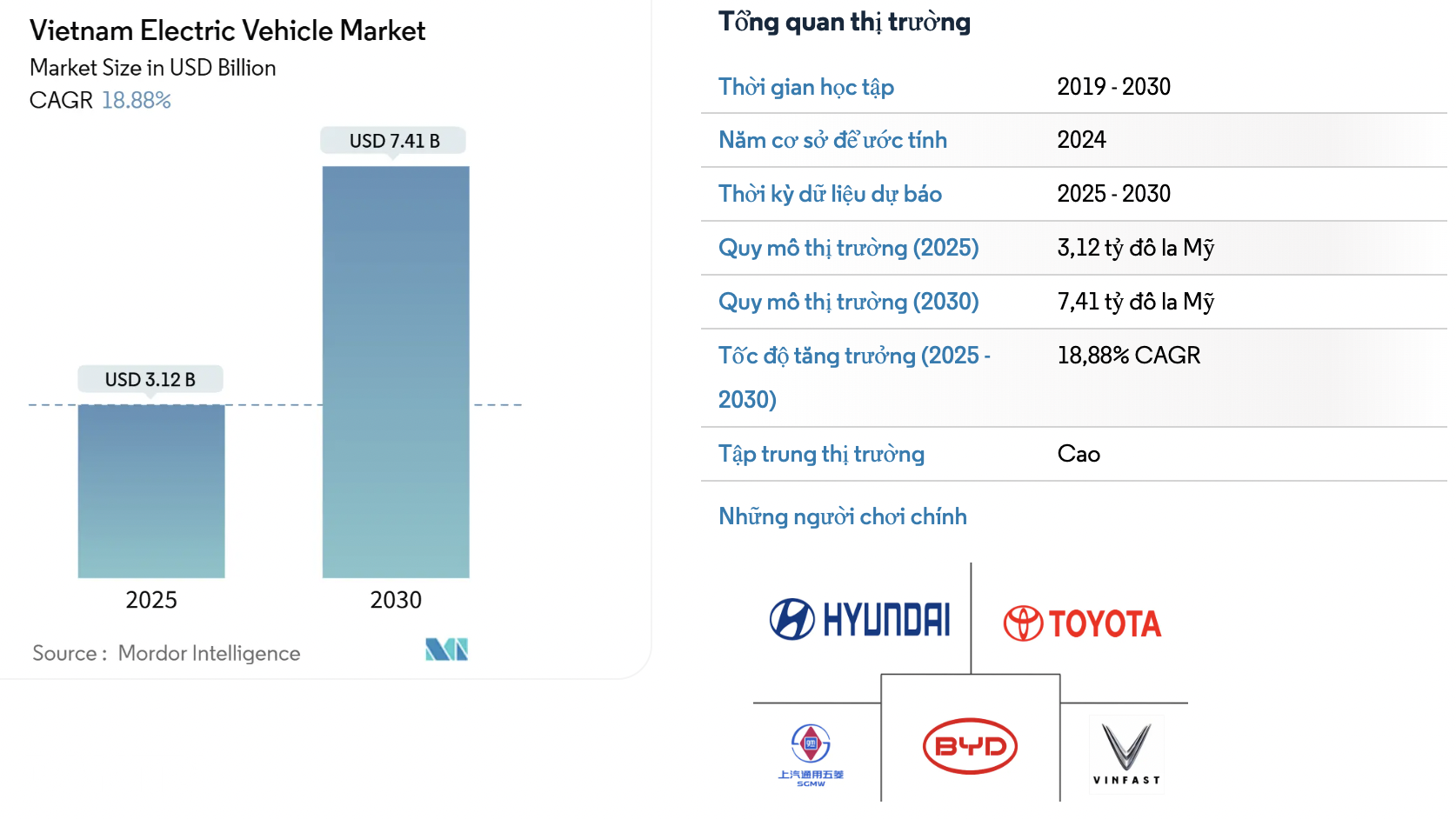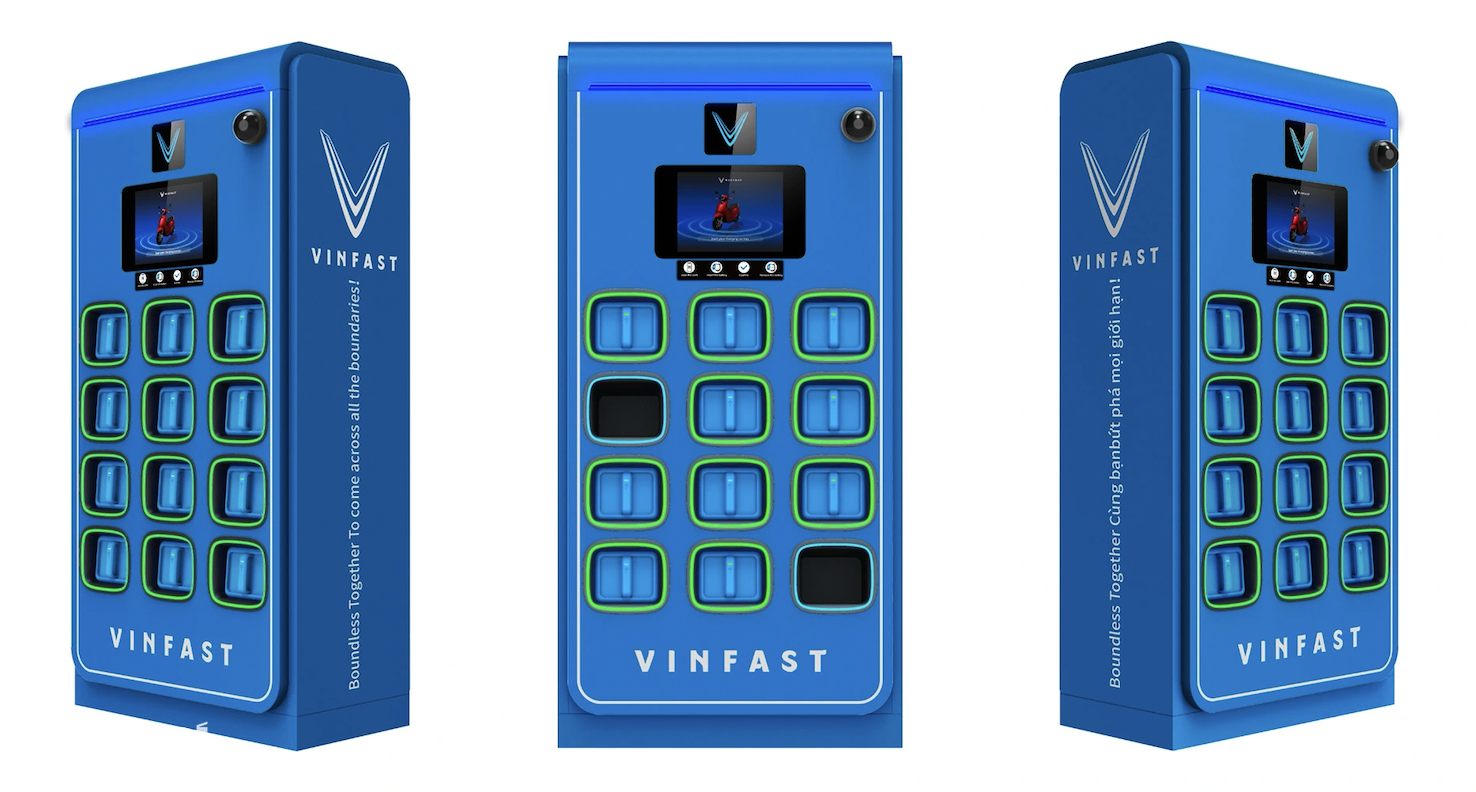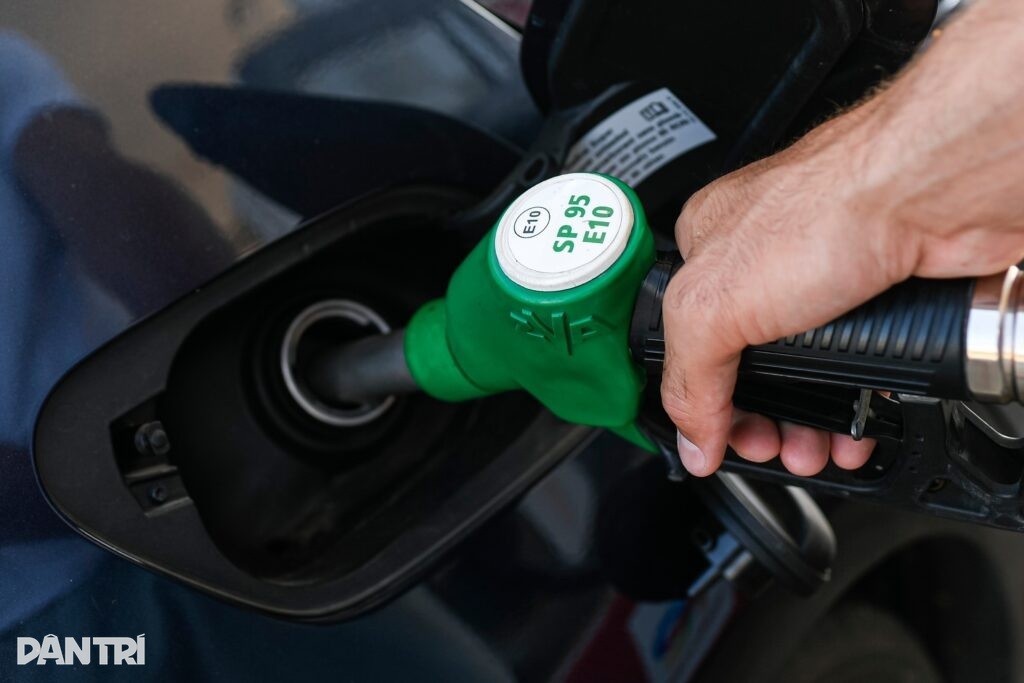Electric vehicles are becoming an important part of the world's automobile industry, and Vietnam is no exception to this trend.
In 2024, the Vietnamese car market will grow rapidly in the application of electric vehicles with the "locomotive" VinFast followed by assembled and imported car manufacturers. In 2025, this wave will be strongly promoted by the determination to develop green transportation and reduce emissions.
Research from Mordor Intelligence forecasts that the size of the Vietnamese electric vehicle market is estimated to reach US$3.12 billion by 2025 and is expected to reach US$7.41 billion by 2030, with a compound annual growth rate (CAGR) of 18.88% during the forecast period (2019-2030).
In the medium term, growing demand for fuel-efficient, high-performance and low-emission vehicles, increasingly stringent laws and regulations on vehicle emissions... are expected to drive this market growth.

Potential of Vietnam's electric vehicle market (Photo: Mordor Intelligence Report).
This September, the Ho Chi Minh City Department of Construction will submit to the Ho Chi Minh City People's Council a project to convert 400,000 gasoline-powered motorbikes to electric ones. The project proposes establishing a low-emission zone in the central area from 2026 to limit service motorbikes that do not meet Euro 2 standards and commercial cars that do not meet Euro 4 standards.
The conversion goal is to reduce emissions and improve environmental pollution, especially in big cities.
To facilitate drivers' conversion, Ho Chi Minh City has proposed that the Central Government exempt registration fees and VAT for the first two years for new electric vehicles and technology vehicle drivers.
On the business side, VinFast also continuously launches great incentives to support users by announcing a 4% discount for all customers when buying cars and electric motorbikes of this brand or interest rate support policies, discounts on car prices, free battery charging...
As one of the prominent players in the Vietnamese electric vehicle market, the company also announced that it will deploy a dense battery swap system of up to 150,000 stations in all localities; at the same time, it will launch battery swap versions of its current electric motorbike models. In October, the company plans to install the first 1,000 battery swap stations, aiming to reach 50,000 battery swap stations by the end of this year and complete the entire system within the next 3 years.

VinFast attracts attention with its battery swapping system (Photo: VFS).
Businesses "massively" join in
A “formidable” competitor of VinFast is TMT Motors - a company whose predecessor was the Transport Equipment and Materials Trading and Manufacturing Company.
TMT Motors has long been known as a company with famous truck products such as Cuu Long, Tata, Howo, Sinotruk tractors... with large loads. Since 2024, this company has attracted attention when participating in the electric vehicle market by manufacturing, assembling and distributing the famous Chinese electric vehicle model, Wuling Hongguang MiniEV, in the Vietnamese market.
The small electric car models distributed by the company are considered competitors of VinFast VF3 - the "darling" of billionaire Pham Nhat Vuong.
In 2025, the company plans to sell more than 8,075 vehicles in 2025, of which light trucks (3,456 vehicles) and electric vehicles (3,404 vehicles) are the two main products. The revenue target (excluding VAT) is nearly VND 3,839 billion, pre-tax profit is nearly VND 300 billion.
The company has just approved a plan to invest in at least 30,000 charging stations (equivalent to 60,000 charging guns) by 2030 according to European standards (CCS2) and other standards according to actual requirements, with a capacity of 7kW or more.
Or Mai Linh Group has just surprised everyone by announcing plans to invest heavily in electric vehicles from 2025. This is considered a step to both replace old fleets and expand the taxi business model in a green, clean, and cost-saving direction.
Previously, Mai Linh was determined to say no to electric cars. At the annual general meeting of shareholders held in April 2024, Mr. Ho Huy - Chairman of the Board of Directors of Mai Linh Group - announced that he would not invest in pure electric cars.
At that time, although electric vehicles were becoming a popular trend in many countries around the world and in Vietnam, electric vehicles were also widely accepted by consumers thanks to the benefits they brought. However, after in-depth research and analysis, Mai Linh realized that electric vehicles were not really suitable and optimal in the Vietnamese market due to infrastructure shortcomings as well as risks related to battery waste.
In the recent change, Mr. Ho Huy frankly expressed: “We understand that we cannot continue to follow the old path. Therefore, Mai Linh has been and is making a strong transformation. Not only in technology, but also in leadership thinking, management model, corporate culture and development orientation”.
At this year's meeting, Mai Linh agreed to add a taxi transport business model using electric vehicles.
More than just electric cars: From the E10 biofuel proposal
The trend is like that, but there are still many problems that need to be solved, from incomplete charging station infrastructure, to technical problems and conversion support costs. Therefore, electric vehicles are considered a medium- and long-term problem.
In the overall green transportation picture, electric vehicles are actually only a part. In the short term, many solutions for green transportation are also being promoted, specifically the use of E10 biofuel and hybrid vehicles.

The Ministry of Industry and Trade proposed that from January 1, 2026, all gasoline used for cars and motorbikes nationwide must be E10 gasoline.
In the latest announcement, the Ministry of Industry and Trade proposed that from January 1, 2026, all gasoline blended, mixed, and sold for use in cars and gasoline motorbikes nationwide must be E10 gasoline.
The ministry believes that continuing to use gasoline-powered vehicles, especially E10 biofuel, brings many economic benefits such as taking advantage of existing infrastructure, avoiding large costs for charging stations and replacing electric vehicle batteries.
Not to mention, gasoline contributes 250,000-300,000 billion VND/year to the budget through taxes, while electric vehicles are receiving strong incentives, reducing budget revenue and increasing pressure on public investment. Therefore, the Ministry considers E10 an immediate and low-cost public health intervention solution.
In other developments, the hybrid car market is also accelerating strongly, although its market share compared to electric and gasoline cars is still quite modest. According to experts, hybrid cars are the fastest solution to reduce emissions today, also help save fuel and do not depend on the network of charging stations.
According to a report from the Vietnam Automobile Manufacturers Association (VAMA), the proportion of electric and hybrid vehicles in the total number of passenger cars in the first half of this year accounted for over 40%. Of which, hybrid vehicles only accounted for 3% of the market share, but witnessed a doubling compared to the same period. Meanwhile, electric vehicles increased from 17% to 37%.
According to VAMA sales figures, in June, the total number of hybrid cars sold by VAMA members reached 1,153, an increase of 183 cars compared to the previous month and accounting for about 3.6% of the total number of new cars of all types sold in Vietnam in June.
Notably, this is the first month of the year that hybrid car sales in Vietnam have exceeded 1,000 vehicles/month.
In the past 6 months, the total number of hybrid cars sold in Vietnam reached 5,658, an increase of 2,210 cars or 39% compared to the same period last year. This result shows that hybrid cars in general are increasingly popular with Vietnamese people.
Even the traditional taxi "boss" chooses its own path
Sharing about hybrid cars, Mr. Nguyen Dinh Hung - Lecturer of the Department of Automotive Engines, Faculty of Traffic Engineering, University of Technology - Ho Chi Minh City National University - said that currently there are two popular types of hybrid cars on the market: hybrid cars (HEV) and plug-in hybrid cars (PHEV).
HEVs use both a gasoline engine and an electric motor. PHEVs are similar to HEVs, but have larger batteries that can be charged by plugging into an electrical outlet, allowing the vehicle to operate entirely on electricity for a certain distance.
Thus, compared to electric vehicles when traveling long distances, the driver must calculate the charging station and the remaining battery capacity, the PHEV hybrid vehicle will be more optimal. According to Mr. Hung, due to the mechanism of rotating the engine between electric vehicles and gasoline vehicles, hybrid vehicles will support the reduction of emissions. However, due to the structure with an additional internal combustion engine, the price of hybrid vehicles is generally higher than current gasoline vehicles and electric vehicles.
From a business perspective, a Motul representative emphasized: “In the context of Vietnam promoting its green transportation strategy, hybrid vehicles, although accounting for a small proportion compared to other vehicle lines, are also growing rapidly thanks to their ability to save fuel, reduce emissions and reliability in operation. Grasping the increasing demand, Motul has researched and developed the NGEN hybrid product to meet it.”
Or taxi company Vinasun also plans to spend another thousand billion VND to buy 1,200 hybrid cars this year. The company has invested 800 billion VND in this car line. In 2025, Vinasun plans to invest in an additional 400 new cars, mainly Toyota hybrid cars.
At the general meeting of shareholders held in May, many shareholders expressed concerns about the cost pressure when investing in hybrid cars. Deputy General Director Tran Anh Minh explained the reason for choosing hybrid cars because this is a car line with many outstanding advantages such as saving 1.5-2 times more fuel than other types of cars.
In addition, according to Vinasun, hybrid cars are suitable for current infrastructure conditions and do not require worrying about charging stations. According to the company, this is a quick solution to develop green transportation.
Globally, the hybrid car market in China is expected to grow by 65% by 2024 (GFK 2024 Market Report). In South Korea, hybrid cars accounted for nearly 1/3 of all new registrations by the end of 2023. In Japan, this type of car is expected to grow with a CAGR of 9.5%, in 2023 hybrid cars will contribute to 55% of total sales of standard-sized passenger cars in 2023...
Source: https://dantri.com.vn/kinh-doanh/xe-dien-hybrid-xang-e10-va-bai-toan-cua-cac-dai-gia-o-viet-nam-20250827141711775.htm





![[Photo] Parade to celebrate the 50th anniversary of Laos' National Day](/_next/image?url=https%3A%2F%2Fvphoto.vietnam.vn%2Fthumb%2F1200x675%2Fvietnam%2Fresource%2FIMAGE%2F2025%2F12%2F02%2F1764691918289_ndo_br_0-jpg.webp&w=3840&q=75)




























![[Photo] Worshiping the Tuyet Son statue - a nearly 400-year-old treasure at Keo Pagoda](/_next/image?url=https%3A%2F%2Fvphoto.vietnam.vn%2Fthumb%2F1200x675%2Fvietnam%2Fresource%2FIMAGE%2F2025%2F12%2F02%2F1764679323086_ndo_br_tempimageomw0hi-4884-jpg.webp&w=3840&q=75)






































































Comment (0)